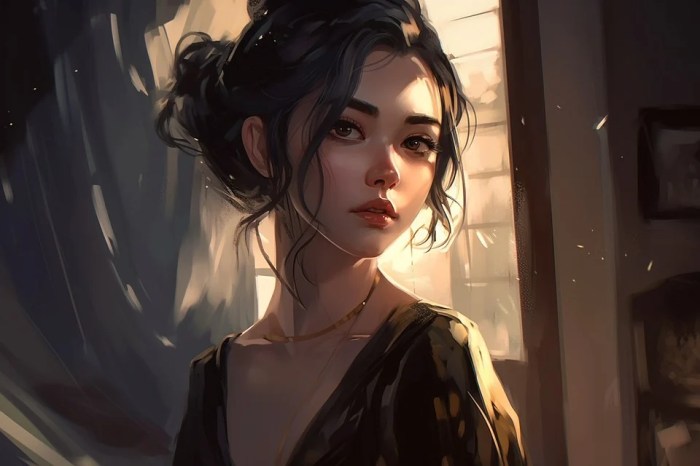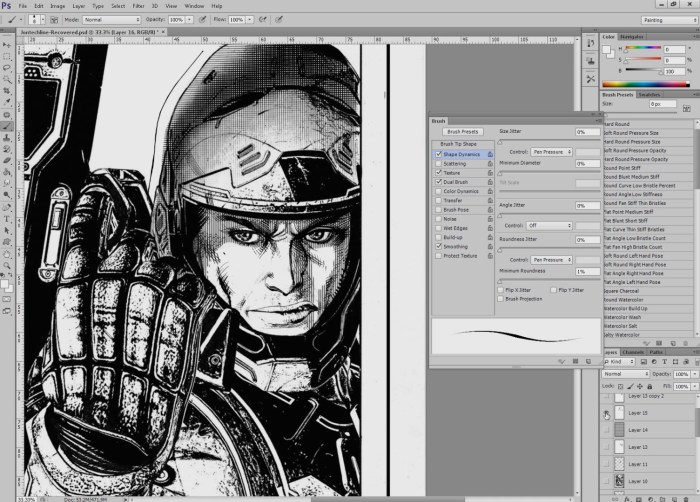Software and Tools

Digital anime art coloring techniques – Choosing the right digital painting software is crucial for achieving the desired look and feel in your anime art. The software you select will significantly impact your workflow, the types of brushes available, and your overall creative process. This section will explore three popular options, highlighting their strengths and weaknesses, along with essential tools and techniques.
Digital Painting Software Comparison
Photoshop, Clip Studio Paint, and Procreate are leading contenders in the digital art world, each offering unique features catering to different artistic styles and workflows. Photoshop, a veteran in image editing, boasts extensive functionality and industry-standard features. Clip Studio Paint, specifically designed for illustration and comics, offers powerful inking and coloring tools tailored to the needs of artists working in anime and manga styles.
Procreate, a mobile application, stands out for its intuitive interface and impressive performance on iPad devices, making it a portable and accessible option. While Photoshop excels in photo manipulation and complex effects, Clip Studio Paint provides superior tools for line art and seamless coloring. Procreate’s ease of use and portability are its biggest draws, though its functionality might be limited compared to the desktop counterparts.
Essential Brushes and Tools
The selection of brushes significantly impacts the final result. Understanding the function of each brush type and choosing the right tool for the job is crucial for efficient and effective digital painting.
| Software | Brush Name | Function | Example Use |
|---|---|---|---|
| Photoshop | Hard Round Brush | Precise lines and details | Inking sharp lines for hair and eyes |
| Photoshop | Soft Round Brush | Blending and shading | Creating smooth gradients for skin tones |
| Photoshop | Airbrush | Soft, diffused effects | Adding subtle highlights and glows |
| Clip Studio Paint | Mapping Pen | Consistent line weight | Creating dynamic and expressive line art |
| Clip Studio Paint | Watercolor Brush | Blending and texture | Painting soft, textured backgrounds |
| Clip Studio Paint | Digital Sumi Brush | Ink-like textures | Adding depth and detail to clothing folds |
| Procreate | Monoline Brush | Clean, consistent lines | Creating precise line art for characters |
| Procreate | Wet Media Brush | Realistic blending and texture | Painting natural-looking skin and hair |
| Procreate | Airbrush | Soft, diffused effects | Adding highlights to hair and clothing |
Color Management and Profiles
Maintaining consistent color across different devices and software is essential for achieving accurate color reproduction in your final artwork. Utilizing color profiles (such as sRGB or Adobe RGB) ensures that the colors you see on your screen are accurately represented in print or on other displays. Ignoring color management can lead to significant discrepancies between your intended colors and the final output.
For example, colors appearing vibrant on one monitor may appear dull on another if the color profiles are not properly managed.
Layer Management Techniques
Efficient layer management is fundamental to a streamlined workflow. Organizing layers logically, using naming conventions, and employing techniques like clipping masks and blending modes allow for easy editing and non-destructive workflows. For instance, separating elements such as line art, base colors, shadows, and highlights into individual layers allows for adjustments to be made without affecting other parts of the illustration.
Using clipping masks keeps effects confined to a specific layer, preventing unintended color bleed. Blending modes offer a wide array of creative possibilities, allowing for more complex interactions between layers, such as multiplying shadows or overlaying highlights.
Style and Aesthetics: Digital Anime Art Coloring Techniques

The aesthetic choices in digital anime art coloring significantly impact the final piece, extending beyond mere technical skill to encompass artistic expression and storytelling. Understanding the nuances of different anime styles and their corresponding color palettes is crucial for achieving the desired mood and atmosphere. This section explores the interplay between anime style, color selection, lighting, and the resulting emotional impact.
Anime Style Influence on Coloring Techniques
Different anime styles inherently dictate different coloring approaches. The clean lines and vibrant colors of a “kawaii” style, for instance, contrast sharply with the more muted, realistic palettes often found in “seinen” anime. A “magical girl” anime might employ bright, pastel shades and glowing effects, while a darker, more mature series might utilize a desaturated palette with deeper shadows and richer blacks.
The style’s inherent characteristics – line weight, character design, and overall visual language – directly influence the coloring techniques used to maintain visual consistency and thematic coherence. Consider, for example, the difference between the bold, cel-shaded coloring frequently seen in action-oriented anime versus the more subtle, painterly approach often found in slice-of-life shows.
Color Choice and Atmospheric Impact
Color is a powerful tool for setting the mood and atmosphere of an anime artwork. Warm colors like reds, oranges, and yellows evoke feelings of warmth, energy, and excitement. They are frequently used in action scenes or to highlight moments of joy and passion. Conversely, cool colors such as blues, greens, and purples tend to create a calmer, more melancholic, or mysterious atmosphere.
They are often used in scenes depicting sadness, tranquility, or suspense. The saturation of colors also plays a crucial role. Highly saturated colors create a vibrant, almost hyperreal effect, while desaturated colors produce a more subdued, realistic feel. The strategic use of color temperature can also be impactful; a warm light source casting cool shadows can create a dramatic and unsettling contrast.
Lighting Scenarios and Color Shifts
Let’s examine how different lighting scenarios alter the coloring process. Imagine a character standing in bright sunlight. The areas directly exposed to the sun will be brightly lit, exhibiting warmer, more saturated colors. Areas in shadow will be cooler and darker, potentially showing bluish or purplish hues. Conversely, consider a scene bathed in the soft glow of moonlight.
The overall palette will shift towards cooler tones, with shadows becoming deeper and more pronounced. The colors will be less saturated, creating a more serene, almost ethereal atmosphere. A scene illuminated by artificial light, like a streetlamp, will present a different effect again. The light source’s color temperature will influence the overall color cast, potentially leading to a warmer or cooler overall palette, depending on the lamp’s color.
The intensity of the light will also dictate the contrast and saturation levels.
Comparative Analysis of Anime Color Palettes, Digital anime art coloring techniques
The emotional impact of color palettes is significant in anime. Different genres employ distinct color schemes to reinforce their narrative and thematic elements.
| Palette | Dominant Colors | Emotional Impact | Anime Genre |
|---|---|---|---|
| Pastel Dreams | Light pinks, blues, yellows | Innocence, sweetness, dreamlike | Magical Girl, Slice of Life |
| Cyberpunk Grit | Deep blues, neon pinks, greens, blacks | Dystopian, futuristic, intense | Cyberpunk, Sci-Fi |
| Samurai Serenity | Muted greens, browns, deep reds | Calm, traditional, stoic | Historical, Samurai |
| Action Intensity | Vibrant reds, oranges, yellows | Energy, excitement, danger | Action, Shonen |
Yo, so you’re into digital anime art coloring techniques, right? Mastering those cel-shading skills is key, but sometimes you need inspiration from unexpected places. Check out these awesome coloring pages arctic plants and animals for some unique color palettes and textures – the icy blues and crisp whites could totally translate into a killer anime background! Then, you can apply those fresh ideas back to your digital anime coloring.
